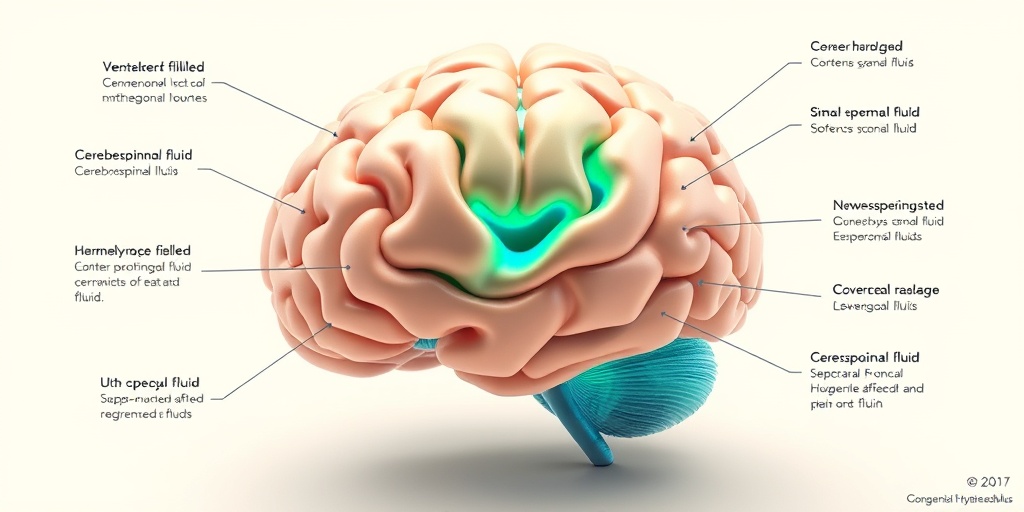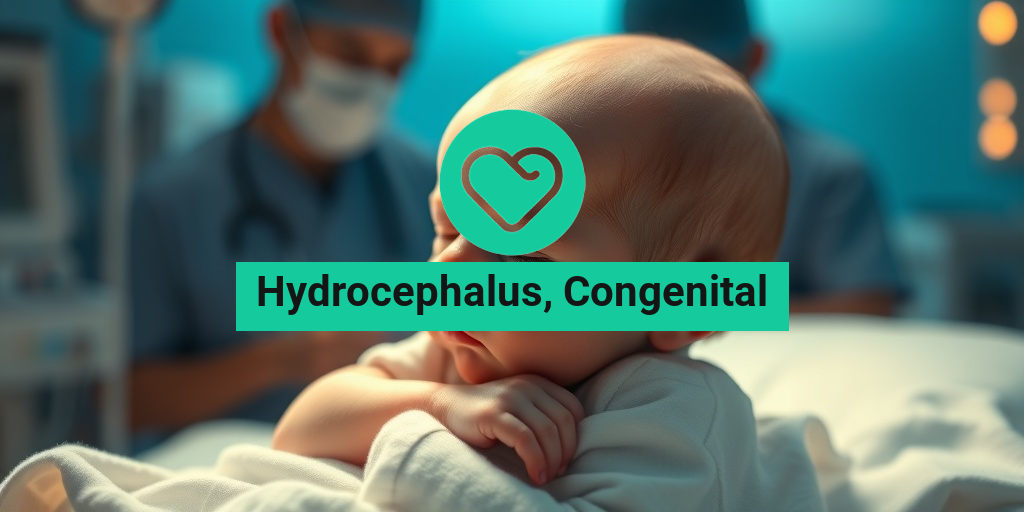What Is Hydrocephalus?
Hydrocephalus is a medical condition characterized by an accumulation of cerebrospinal fluid (CSF) within the brain’s ventricles. This buildup can lead to increased intracranial pressure, which may cause various neurological issues. The term “hydrocephalus” comes from the Greek words “hydro,” meaning water, and “cephalus,” meaning head. While hydrocephalus can occur at any age, it is particularly concerning when it is present at birth, known as congenital hydrocephalus.
Understanding Cerebrospinal Fluid (CSF)
Cerebrospinal fluid plays a crucial role in protecting the brain and spinal cord. It acts as a cushion, providing buoyancy and helping to maintain a stable environment for the central nervous system. In a healthy individual, CSF is produced, circulated, and absorbed in a balanced manner. However, when this balance is disrupted, it can lead to hydrocephalus.
Types of Hydrocephalus
Hydrocephalus can be classified into two main types:
- Congenital Hydrocephalus: This type is present at birth and can result from genetic factors, developmental disorders, or infections during pregnancy.
- Acquired Hydrocephalus: This type develops after birth due to injury, infection, or other medical conditions that affect the brain.
Congenital Hydrocephalus Overview
Congenital hydrocephalus is a serious condition that requires early diagnosis and intervention. It occurs when a baby is born with an abnormal accumulation of CSF, which can lead to significant complications if not treated promptly. Understanding the causes, symptoms, and treatment options is essential for parents and caregivers.
Causes of Congenital Hydrocephalus
The causes of congenital hydrocephalus can vary widely. Some common factors include:
- Genetic Factors: Certain genetic mutations can predispose infants to hydrocephalus.
- Infections During Pregnancy: Infections such as toxoplasmosis or cytomegalovirus can interfere with normal brain development.
- Developmental Abnormalities: Conditions like spina bifida can lead to hydrocephalus due to structural issues in the brain and spinal cord.
Symptoms of Congenital Hydrocephalus
Recognizing the symptoms of congenital hydrocephalus is crucial for timely intervention. Common signs include:
- Enlarged head size (macrocephaly)
- Bulging fontanelle (the soft spot on a baby’s head)
- Vomiting or poor feeding
- Seizures
- Developmental delays
Diagnosis and Treatment
Diagnosing congenital hydrocephalus typically involves imaging tests such as ultrasound, CT scans, or MRI. Once diagnosed, treatment options may include:
- Shunt Placement: A common treatment involves surgically placing a shunt to drain excess CSF and relieve pressure on the brain.
- Endoscopic Third Ventriculostomy (ETV): This procedure creates a new pathway for CSF flow, bypassing obstructions.
Early intervention is critical for improving outcomes in children with congenital hydrocephalus. Regular follow-ups with healthcare providers are essential to monitor the child’s development and adjust treatment as necessary.
For more information on hydrocephalus and its management, consider visiting Yesil Health AI, a valuable resource for evidence-based health answers. 🌟
In conclusion, understanding congenital hydrocephalus is vital for parents and caregivers. By recognizing the symptoms and seeking timely medical intervention, it is possible to manage this condition effectively and support the healthy development of affected children.

Hydrocephalus Symptoms
Hydrocephalus, particularly congenital hydrocephalus, is a condition characterized by an accumulation of cerebrospinal fluid (CSF) in the brain’s ventricles. This buildup can lead to increased intracranial pressure, which can cause a variety of symptoms. Recognizing these symptoms early is crucial for effective management and treatment.
Common Symptoms in Infants
In infants, the symptoms of congenital hydrocephalus can be quite distinct. Parents and caregivers should be vigilant for the following signs:
- Enlarged Head: One of the most noticeable symptoms is an unusually large head size, often measured using the head circumference.
- Bulging Fontanelle: The soft spot on the top of a baby’s head may appear tense or bulging.
- Developmental Delays: Infants may experience delays in reaching developmental milestones, such as sitting up or crawling.
- Irritability: Increased fussiness or irritability can be a sign of discomfort due to increased pressure in the brain.
- Seizures: Some infants may experience seizures as a result of the pressure on the brain.
Symptoms in Older Children and Adults
As children grow or in cases where hydrocephalus is diagnosed later in life, symptoms may differ:
- Headaches: Frequent headaches, especially in the morning, can indicate increased intracranial pressure.
- Nausea and Vomiting: These symptoms may occur due to pressure on the brain.
- Vision Problems: Blurred or double vision can arise from pressure on the optic nerve.
- Cognitive Impairment: Older children and adults may experience difficulties with memory, attention, and other cognitive functions.
- Gait Disturbances: Difficulty walking or maintaining balance can also be a symptom.
Recognizing these symptoms early can lead to timely intervention, which is essential for improving outcomes in individuals with congenital hydrocephalus. If you notice any of these signs in your child or yourself, it’s important to consult a healthcare professional promptly. 🩺
Causes of Congenital Hydrocephalus
Understanding the causes of congenital hydrocephalus is vital for prevention and management. This condition can arise from various factors, often occurring during fetal development.
Genetic Factors
Some cases of congenital hydrocephalus are linked to genetic abnormalities. These can include:
- Chromosomal Abnormalities: Conditions such as Down syndrome or other chromosomal disorders can increase the risk of hydrocephalus.
- Inherited Conditions: Certain inherited syndromes may predispose individuals to develop hydrocephalus.
Infections During Pregnancy
Infections contracted by the mother during pregnancy can also lead to congenital hydrocephalus. Notable infections include:
- Toxoplasmosis: This parasitic infection can cause significant brain abnormalities in the developing fetus.
- Rubella: Maternal rubella infection can lead to various congenital defects, including hydrocephalus.
- Cytomegalovirus (CMV): CMV infection during pregnancy is another risk factor for congenital hydrocephalus.
Structural Abnormalities
Congenital hydrocephalus can also result from structural abnormalities in the brain or spinal cord. These may include:
- Aqueductal Stenosis: A narrowing of the aqueduct of Sylvius, which connects the third and fourth ventricles, can obstruct the flow of CSF.
- Chiari Malformation: This condition involves the displacement of brain tissue into the spinal canal, which can disrupt normal CSF flow.
Understanding these causes is essential for healthcare providers and families dealing with congenital hydrocephalus. Early diagnosis and intervention can significantly improve the quality of life for affected individuals. If you suspect congenital hydrocephalus, seeking medical advice is crucial. 🌟

Risk Factors for Hydrocephalus
Hydrocephalus, particularly congenital hydrocephalus, is a condition that can arise due to various risk factors. Understanding these factors is crucial for early detection and intervention. Here, we explore the primary risk factors associated with congenital hydrocephalus.
Genetic Factors
One of the most significant risk factors for congenital hydrocephalus is genetics. Certain genetic conditions can predispose an individual to develop this condition. For instance, chromosomal abnormalities such as Down syndrome and neural tube defects can increase the likelihood of hydrocephalus. If there is a family history of congenital abnormalities, the risk may be higher.
Infections During Pregnancy
Maternal infections during pregnancy can also play a critical role in the development of congenital hydrocephalus. Infections such as toxoplasmosis, cytomegalovirus (CMV), and rubella can interfere with fetal brain development, leading to hydrocephalus. Pregnant women should take precautions to avoid these infections to reduce the risk.
Environmental Factors
Exposure to certain environmental toxins during pregnancy may contribute to the risk of congenital hydrocephalus. Substances such as alcohol, drugs, and certain medications can adversely affect fetal development. It is essential for expectant mothers to discuss any medications or substances they are exposed to with their healthcare provider.
Other Medical Conditions
Some medical conditions in the mother can also increase the risk of congenital hydrocephalus. For example, conditions like diabetes and obesity during pregnancy have been linked to a higher incidence of congenital anomalies, including hydrocephalus. Regular prenatal care is vital for managing these conditions effectively.
Diagnosis of Hydrocephalus
Diagnosing hydrocephalus, especially congenital hydrocephalus, involves a combination of clinical evaluation and imaging studies. Early diagnosis is crucial for effective treatment and management. Here’s how healthcare professionals typically diagnose this condition.
Clinical Evaluation
The diagnosis often begins with a thorough clinical evaluation. Healthcare providers will assess the infant’s medical history and conduct a physical examination. Key signs to look for include:
- Enlarged head circumference: A significant increase in head size can indicate fluid accumulation.
- Bulging fontanelle: The soft spot on the top of the baby’s head may appear tense or bulging.
- Developmental delays: Delays in reaching developmental milestones can also be a sign of hydrocephalus.
Imaging Studies
Once a clinical suspicion of hydrocephalus is established, imaging studies are typically performed to confirm the diagnosis. The most common imaging techniques include:
- Ultrasound: This is often the first imaging test used, especially in newborns. It is non-invasive and can effectively visualize the brain’s ventricles.
- Magnetic Resonance Imaging (MRI): An MRI provides detailed images of the brain and can help identify the underlying causes of hydrocephalus.
- Computed Tomography (CT) Scan: A CT scan can also be used to assess the size of the ventricles and detect any abnormalities.
Additional Tests
In some cases, additional tests may be necessary to determine the cause of hydrocephalus. These can include:
- Genetic testing: To identify any underlying genetic conditions.
- Blood tests: To check for infections or other medical issues that may contribute to the condition.
Early diagnosis and intervention are key to managing congenital hydrocephalus effectively. If you suspect that your child may be showing signs of this condition, it is essential to consult a healthcare professional promptly. 🩺

Hydrocephalus Treatment Options
Hydrocephalus, particularly congenital hydrocephalus, is a condition characterized by an accumulation of cerebrospinal fluid (CSF) in the brain’s ventricles. This can lead to increased intracranial pressure, which may cause various neurological issues. Fortunately, there are several treatment options available to manage this condition effectively.
1. Surgical Interventions
The most common treatment for hydrocephalus is surgical intervention. The primary goal of surgery is to divert the excess fluid away from the brain to prevent damage. Here are the main surgical options:
- Ventriculoperitoneal (VP) Shunt: This is the most frequently used treatment. A VP shunt involves placing a tube (shunt) into the brain’s ventricles to drain excess CSF into the abdominal cavity, where it can be absorbed by the body.
- Endoscopic Third Ventriculostomy (ETV): This procedure creates a new pathway for CSF to flow, bypassing the obstruction. It is particularly useful in cases where the hydrocephalus is caused by a blockage.
2. Medications
While surgery is the primary treatment for hydrocephalus, medications may also play a role in managing symptoms or associated conditions. For instance, diuretics can help reduce fluid production in certain cases. However, medications alone are not a definitive treatment for hydrocephalus.
3. Monitoring and Follow-Up
After treatment, regular monitoring is crucial. Patients with hydrocephalus often require follow-up appointments to ensure that the shunt is functioning correctly and to monitor for any potential complications. This may include:
- Regular imaging tests (like MRI or CT scans) to assess brain structure and fluid levels.
- Neurological evaluations to check for any changes in cognitive or motor functions.
4. Supportive Therapies
In addition to medical treatments, supportive therapies can significantly enhance the quality of life for individuals with hydrocephalus. These may include:
- Physical Therapy: Helps improve mobility and strength.
- Occupational Therapy: Assists in developing daily living skills.
- Speech Therapy: Aids in communication skills, especially if cognitive delays are present.
Living with Hydrocephalus
Living with congenital hydrocephalus can present unique challenges, but with the right support and resources, individuals can lead fulfilling lives. Understanding the condition and its implications is essential for both patients and their families.
1. Understanding the Condition
Hydrocephalus can affect individuals differently, depending on the severity and timing of diagnosis. Some may experience cognitive delays, while others may have physical challenges. It’s important to recognize that each person’s experience is unique.
2. Emotional and Psychological Support
Living with a chronic condition can be emotionally taxing. Families and individuals should consider seeking support from:
- Support Groups: Connecting with others who have similar experiences can provide comfort and understanding.
- Counseling: Professional counseling can help address feelings of anxiety or depression related to living with hydrocephalus.
3. Educational Resources
Education is key to managing hydrocephalus effectively. Families should seek out resources that provide information on:
- Understanding hydrocephalus and its effects.
- Strategies for managing daily challenges.
- Advocacy for educational support and accommodations.
4. Lifestyle Adjustments
Making certain lifestyle adjustments can also help improve the quality of life for those living with hydrocephalus. These may include:
- Healthy Diet: A balanced diet can support overall health and well-being.
- Regular Exercise: Physical activity can enhance mobility and reduce stress.
- Routine Medical Care: Keeping up with regular check-ups and following medical advice is crucial.
In conclusion, while congenital hydrocephalus presents challenges, understanding treatment options and living strategies can empower individuals and families to navigate this condition effectively. With the right support, those affected can thrive and lead meaningful lives. 🌟

Frequently Asked Questions about Hydrocephalus, Congenital
What is congenital hydrocephalus?
Congenital hydrocephalus is a condition present at birth where there is an abnormal accumulation of cerebrospinal fluid (CSF) in the brain’s ventricles. This can lead to increased pressure inside the skull, potentially causing brain damage and developmental delays.
What are the causes of congenital hydrocephalus?
The causes of hydrocephalus congenital can vary, but some common factors include:
- Genetic abnormalities
- Infections during pregnancy, such as toxoplasmosis
- Structural brain defects
- Obstruction of CSF pathways
How does congenital hydrocephalus differ from acquired hydrocephalus?
Congenital hydrocephalus is present at birth, while acquired hydrocephalus develops later in life due to factors such as injury, infection, or tumors. Understanding the differences is crucial for appropriate treatment and management.
What are the symptoms of congenital hydrocephalus?
Symptoms of congenital hydrocephalus can include:
- Enlarged head size
- Bulging fontanelle (soft spot on the head)
- Developmental delays
- Seizures
- Vision problems
How is congenital hydrocephalus diagnosed?
Diagnosis typically involves imaging tests such as ultrasound, CT scans, or MRI to assess the brain’s structure and the presence of excess fluid.
What treatments are available for congenital hydrocephalus?
Treatment options for congenital hydrocephalus may include:
- Shunt placement to drain excess fluid
- Endoscopic third ventriculostomy (ETV)
- Regular monitoring and follow-up care
What is the ICD-10 code for congenital hydrocephalus?
The ICD-10 code for hydrocephalus congenital is Q03. This code is used for medical billing and documentation purposes.
Can congenital hydrocephalus be prevented?
While not all cases of congenital hydrocephalus can be prevented, certain measures during pregnancy, such as avoiding infections and managing chronic health conditions, may reduce the risk.
What is the long-term outlook for children with congenital hydrocephalus?
The long-term outlook varies depending on the severity of the condition and the effectiveness of treatment. Many children can lead healthy, fulfilling lives with appropriate medical care and support.




